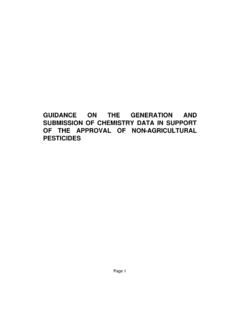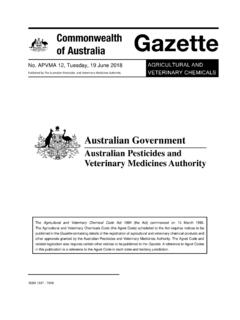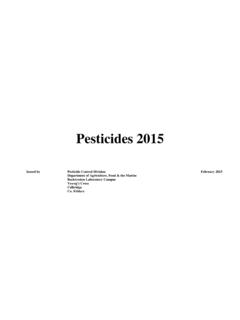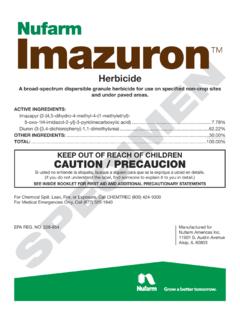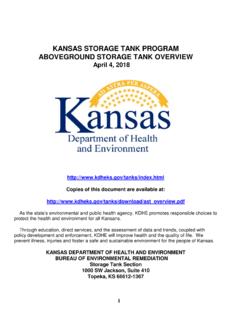Transcription of Pesticides - Guidelines for validation of analytical ...
1 Guidelines FOR validation OF analytical METHODS FOR NON- agricultural PESTICIDE ACTIVE INGREDIENTS AND PRODUCTS. 1 CONTENTS Page 1. INTRODUCTION 2 Background 2 Scope 2 Good Laboratory practice 3 2. METHOD validation 4 What is it?
2 4 Why it is needed 4 What does it entail? 4 3. PARAMETERS OF METHOD validation 5 Accuracy and Precision 5 Specificity (and selectivity)
3 8 Linearity 8 Limit of detection 9 Limit of Quantitation 9 Sensitivity 10 Ruggedness/Robustness 10 4.
4 GENERAL NOTES 11 5. SUMMARY OF REGULATORY REQUIREMENTS 13 GLOSSARY OF TERMS 14 REFERENCES 16 21. Introduction Non- agricultural Pesticides are presently regulated in Great Britain under The Control of Pesticides Regulations (COPR) 1986, as amended, and require approval before they can be sold, supplied, stored, used or advertised. The term non- agricultural pesticide covers wood preservatives, wood treatment products, surface biocides, biocidal paints, rodenticides and insecticides/acaricides for use in public hygiene situations, avicides, bird stupefying baits and antifouling products.
5 This guidance document is one of a series of documents that has been developed by HSE to support the approval of non- agricultural Pesticides under COPR. Background Following agreement of the Advisory Committee of Pesticides , HSE s Biocides and Pesticides Unit (BPU) produced a guidance document Data requirements for non- agricultural Pesticides products and their active substances (found in Part Three/A of the Registration Handbook). The requirements published in July 1993 establish a consolidated (core) set of data requirements for all non- agricultural Pesticides .
6 The core data requirements apply to the registration of a pesticide containing a novel active ingredient but also are used to support the review of older active ingredients and their products. Scope In order to generate data to support the core data requirements for COPR robust, accurate and precise analytical methods are required. analytical data are required for the determination of the active ingredient, impurities, degradation products and residues in the formulation, in water and in certain circumstances in other materials.
7 These Guidelines are intended to provide information and guidance to approval holders responsible for submitting a validated analytical method to the Biocides and Pesticide Unit (BPU) of HSE to support active ingredients and formulations under the Control of Pesticides Regulations 1986 (COPR) (as amended). These Guidelines highlight what is required with respect to validation of analytical methods. In cases where the requirements of these Guidelines cannot be fulfilled, a justification must be submitted. It is not a requirement that the whole validation data set is generated every time a method is used.
8 3 This guidance covers approvals for non- agricultural pesticide products under COPR and the document should be read in conjunction with the 1993 Guidelines on core data requirements. With effect from 31:12:2002 these Guidelines will apply to any new method of analysis submitted to BPU in fulfilment of the core data requirements for the approval of pesticidal active ingredient and products under COPR. This document is available on BPU s website: Good Laboratory Practice (GLP) Good Laboratory Practice (GLP) is concerned with the organisational process and the conditions under which studies are planned, performed, monitored, recorded and reported.
9 The regulations are not concerned with the interpretation and evaluation of test results. The EC Directive 87/18/EEC required member States to take all measures necessary to ensure that safety studies submitted to regulatory authorities in support of notification or registration of certain classes of chemicals were in accordance with GLP. With regard to the position of COPR the following points are relevant. COPR does not make reference to GLP since it predates Directive 87/18/EEC and the UK GLP regulations. However, with respect to the principles of GLP and its applicability to the current statutory scheme for Pesticides , the following arrangements were drawn up following a consultation exercise with approval Holders and interested parties ( Pesticides Newsletter, September 1992 and the Pesticide Register Issue 3, 1992 refer) (i) Mammalian toxicology studies started after 30th June 1988 must be carried out in compliance with the principles of GLP (ii)
10 Physico-chemical studies and ecotoxicology studies after 1st January 1993 must be carried out in compliance with the principles of GLP (iii) All other safety studies started after 1st January 1993 must be carried out in compliance with the principles of GLP Conditions (i), (ii) and (iii) apply to studies submitted either in support of an application for approval under COPR; or to satisfy a requirement for new data arising out of a review of a pesticide active ingredient or co-formulant. In those cases where studies have not been conducted under the principles of GLP this must be justified and the quality assurance procedures used for the study must be described.










